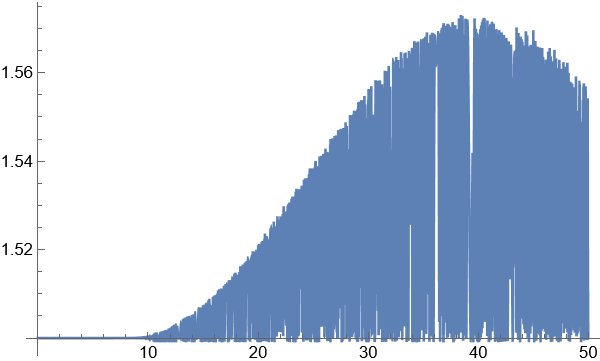I'm using NDSolve for a system of non-linear ODEs. Here is my code
g1 = 5;
g2 = 1;
tbar = 50;
n = 20;
(*declare matrices*)
d0 = IdentityMatrix[n];
d1 = Table[If[i == j, i, 0], {i, 0, n - 1}, {j, 0, n - 1}];
d2 = Table[If[i == j - 1, Sqrt[j], 0], {i, 0, n - 1}, {j, 0, n - 1}];
d3 = Table[If[i == j + 1, Sqrt[j + 1], 0], {i, 0, n - 1}, {j, 0, n - 1}];
(*declare initial variables*)
{x0, p0} = {0, 0};
initc = a[0] == (x0 + I*p0)/Sqrt[2];
{expx0, expp0} = {1, 1};
\[Alpha] = (expx0 + I*expp0)/Sqrt[2];
initq = c[0] == Chop[Normalize@Table[\[Alpha]^i/Sqrt[i!], {i, 0, n - 1}]];
(*differential equations*)
sol = NDSolve[{a'[t] == -I (g1*a[t] + g2/2 c[t].(d2 + d3).Conjugate[c[t]]),
c'[t] == -I*c[t].(d1 + 0.5*d0 + g2*(Re@a[t]) (d2 + d3)),
initc, initq}, {a, c}, {t, 0, tbar}];
(*plotting*)
asol[t_] := a[t] /. sol[[1]]
csol[t_] := c[t] /. sol[[1]]
Plot[{Re@asol[t], Im@asol[t]}, {t, 0, tbar}, PlotRange -> All]
I want to be able to get reliable results for this system for a range of values of the parameters $g1$ and $g2$. The problem arises when I use values which make the non-linear term (the second term) in the first equation large. For example, when I use $g1=5, g2=1$, the solutions are good but when I use $g1=0.5, g2=1$, I can already see that there is something wrong (the values are too large). So essentially the problem seems to be in the ratio $g2/g1$ and I suspect this is due to the non-linearity and perhaps something goes wrong with the NDSolve algorithm (the run times are also much longer for the problematic cases). Is there a way I can make this code work for a larger parameter range?
EDIT: what do I mean by "too large"? I mean the values of Re@asol and Im@asol being large, to see why this is an issue I need some context for this system. This is a problem from physics of a modified harmonic oscillator (MHO) coupled to a quantum harmonic oscillator (QHO). Energy conservation should hold for this system i.e. MHO+QHO+interaction is a constant.This can be checked with the following code
e1[t_] := g1*(Abs@asol[t])^2;
e2[t_] := Chop[csol[t].(d1 + 0.5*d0).Conjugate[csol[t]]];
eint[t_] :=
Chop[csol[t].(g2*(Re@asol[t])*(d2 + d3)).Conjugate[
csol[t]]];
etotal[t_] := e1[t] + e2[t] + eint[t];
{etotal[0], etotal[tbar]}
Energy conservation begins to fail as I go to g2=0.5 (try g2=0.1 for a more dramatic demonstration of this).




g1=0.5;g2=1I get a solution in about 5 seconds in v12.3. Which version are you in? $\endgroup$NDSolveis very robust and should always be the last thing to adjust. (Anyway, I tried adjustingWorkingPrecisionto16, but the solution just looks the same: i.sstatic.net/ZwtUP.png) Are you sure the system itself is correct? $\endgroup$